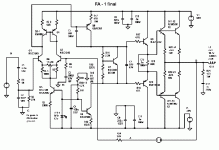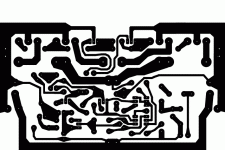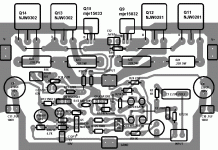MJL21193 said:. . . As for the voltage of your power supply, I recommend you leave it high but reduce the gain of the amp to limit the output. This will leave some voltage headroom to prevent clipping during transients.
That's an interesting option. Indeed, I had planned to make some interesting external preamplifiers just in case the power amp wasn't the bootstrapping sort. So far, the "plays good loud" (a necessary feature for such a powerful amplifier) looks like one of these:
Normal gain, bootstrapping amp.
-or-
Lower gain, external preamplifier, paralleled output devices amp.
It will be interesting to check out the differences.
I'll need to get an extra set of matching output transistors. Aha! That's when the OnSemi document starts making sense, because otherwise its just a cute little thing with more than enough power to bake itself. That's such a good clue. Thanks!!
P.S. With the high attention to detail shown at the power circuit of the amplifier on your thread, then your amplifier will make less heat at the heatsink. This is something I had planned to do as well. For me its been 2:1 proportion more effective at reducing heat than the voltage vs load adjustments.
ostripper said:KSA1381/3503 F is the one. with this grade one does not
need to EF the active side of the VAS (1381) but I might
make the "universal blameless" (FA1)and add pads for EF
in the layout , ability to use a bootstrap or even a
CFP input stage.
OS
Wow! Very interesting!
I think that my shopping list is still a bit incomplete.
Specific model long life LED (from Mouser or MCM)?
All resistors that need more than 1/4w capacity?
Thanks!
keantoken said:. . . .
I have very little real-world experience, as most of my experimenting has been done on the simulator. I've never had the money to do anything. In this case DIYAudio has provided a way for me to reality check my circuits, and to make sure I'm being practical while designing them. But on the side I have also received some criticism for this.. . .
I can help you understand the sim, if you are interested in my assistance I can Email you so you'll have my Email address.
- keantoken
A solution for both has occurred by accident. I have accidentally purchased an extra set of components for this amplifier. What I don't have extra is heatsink, transformer, enclosure. These you can find inside of a dysfunctional Solid State amp sourced from the Goodwill or Salvation Army, Attic, dumpster dive, Ebay snipe, curb find, or garage sale.
So, go ahead and email.
Here is the updated schema that I'm making the board with..
It is a real working amp that I gave to my daughter..
All components are the ones actually operational now.
1/4 watt for all except those listed otherwise..
Wait for the whole package 1/1/09...
It is a real working amp that I gave to my daughter..
All components are the ones actually operational now.
1/4 watt for all except those listed otherwise..
Wait for the whole package 1/1/09...
Attachments
danielwritesbac said:
-or-
Lower gain, external preamplifier, paralleled output devices amp.
Hi Dan,
When I said keep the power supply voltage high but reduce the gain, the objective is to avoid clipping the amp, not to allow the use of a preamp.
The idea is that you will not be utilizing the full voltage swing that the power supply is capable of. If you have an amp that will output 150 watts into 8 ohms (like my Patchwork) but you only really need 100 watts or less, you can go with the specified power supply (in this case +/-56VDC) but reduce the gain so that the input voltage will not drive the amp to clipping. I think I'm explaining this clearly, but let me know if it's not.
In the meantime, a preamp is fine as long as it doesn't overdrive your power amp. There is some confusion that a preamp means quality, because we see so many on the class A amps, such as the Pass Labs amps. Many of these need a preamp because they don't have any voltage gain (or very little) on their own.
The type of amp you are looking to build here has high gain and will handle the signal direct from a CD player etc.
For example, my setup:
I have a Yamaha HTR that is connected to my DCX2496 through the front pre-outs. The DCX is connected to the six amps that drive the individual drivers in my 3-ways. In essence, the Yamaha is the preamp as I don't use any of it's internal amps anymore.
By MJL - In the meantime, a preamp is fine as long as it doesn't overdrive your power amp.
I drive the FA-1 (as schema above) with a SBlive sound card
(1.2v p-p) , never clips. I can clip both of them (FA1/2)on my M-audio Soundcard (at 1.85v p-p) . I have another amp like
FA-1 (quasi amp, same gain) It never clips from my sub out
HT (1.7v)..so you should be all right from most sources.
OS
BTW.. the board is almost done..
(see below)
Attachments
If these are giving excellent presentations from home theater pre and sound cards, then that is a very good sign indeed.
From such sources, a chipamp would require a very creative preamplifier else it would go facefirst on fidelty. Decibel Dungeon posts several solutions on the Buffered gainclone page. Check out that cool transistor miniaturized 50's power amp buffer deal. That thing works very well.
Thus I interpret this comparison as the good news that the input circuit of these discrete amps don't need an add on. Nice.
From such sources, a chipamp would require a very creative preamplifier else it would go facefirst on fidelty. Decibel Dungeon posts several solutions on the Buffered gainclone page. Check out that cool transistor miniaturized 50's power amp buffer deal. That thing works very well.
Thus I interpret this comparison as the good news that the input circuit of these discrete amps don't need an add on. Nice.
ostripper said:
so you should be all right from most sources.
Nice work OS,
Yeah, no, Dan has some interesting ideas about preamps. We "discussed" this before, on the chipamps forum

ostripper said:BTW.. the board is almost done..
(see below)
Oh! Excited!
I had meant to ask about the possibility of using "sensor circuit" instead of an NFB cap.
MJL21193 said:Nice work OS,
Yeah, no, Dan has some interesting ideas about preamps. We "discussed" this before, on the chipamps forum
A relatively pain-free recap would go something like:
The place for such accommodations, like harmonic manipulations and tone controls, is located in a separate preamp unit (when considering amplifiers exceeding 25w).
And, the reason to use such preamps is that most ears don't work like microphones, and most living rooms aren't concert halls. Its that whole Entertainment Industry classification again, necessitating that the concept of "suspension of disbelief" is required before a box can be accepted as a substitute for a performance. If you're not listening to a concert, then you're listening to . . . something else, and I'd rather not.
On this, I like building my own preamplifier-based analog equipment for the sport, and also because most computerized/codebase units blatantly drop information like it was going out of style (no need for that). Its taken me quite a while and quite a sum to purchase music. Therefore I'd like to use it all as well as possible. That definition is up to the audience (me).
Its both unnecessary and limited to convolute larger amplifiers with the means for audio enhancements (except for a few basics that can remove limitations). But, its much more fun to use little, separate, preamplifiers for this, because you can choose whatever you like without having to change the amplifier. And, why would you do it if it wasn't fun?
My opinions on this aren't much different from the general practices of the prosound industry, except that I choose to rescale for home use.
Cheers!
ostripper said:
I drive the FA-1 (as schema above) with a SBlive sound card
(1.2v p-p) , never clips. I can clip both of them (FA1/2)on my M-audio Soundcard (at 1.85v p-p) . I have another amp like
FA-1 (quasi amp, same gain) It never clips from my sub out
HT (1.7v)..so you should be all right from most sources.
OS
BTW.. the board is almost done..
(see below)
Wow that's nice! Its more compact that I thought it would be, because that's like. . . I have this big box of parts and they're all going to go on that board. That's cool!
danielwritesbac said:
The place for such accommodations, like harmonic manipulations and tone controls, is located in a separate preamp unit (when considering amplifiers exceeding 25w).
Dan the Man,
When you have a couple of good amps, a pair of quality speakers and something decent to play a tune through then you will not bother with "tone" controls. These try to make up for the deficiencies in a cheap system and they show up as nothing more than racket makers when you can actually hear their effect.
MJL21193 said:Dan the Man,
When you have a couple of good amps, a pair of quality speakers and something decent to play a tune through then you will not bother with "tone" controls. These try to make up for the deficiencies in a cheap system and they show up as nothing more than racket makers when you can actually hear their effect.
I wasn't thinking of basic tone controls. Those are incredibly difficult to get them seemly. Most are noise. Agreed.
On that subject, I think that Mr. Pass and I have similar ideas. Although I don't know if he use two separate systems (one to relax, the other for exuberance) or if he puts a prosound EQ in a tape loop so it can be easily put into or taken out of the audio chain with the flip of a switch.
Anyway, with the high power amplifier (more than 25W), it seems best if any adjustments/effects are in a separate device, in a separate enclosure.
A more difficult subject comes into play at the point where it is necessary that the amplifier be facilitating towards various usage. This might be as simple as arranging for lower distortions at higher outputs. Or, it might get into a discussion of harmonics. I'm not prepared for that.
One possible facilitation done at the amplifier is using a sensor circuit instead of the NFB cap. That's just an example; however, a cap can skew results, but a sensor circuit is more controllable.
Its almost ironic that the best example I can give for appropriate voicing of an amplifier just happens to be decreasing reliance on such tricks, via adding the sensor circuit.
Anyway, with the high power amplifier (more than 25W), it seems best if any adjustments/effects are in a separate device, in a separate enclosure.
A more difficult subject comes into play at the point where it is necessary that the amplifier be facilitating towards various usage. This might be as simple as arranging for lower distortions at higher outputs. Or, it might get into a discussion of harmonics. I'm not prepared for that.
One possible facilitation done at the amplifier is using a sensor circuit instead of the NFB cap. That's just an example; however, a cap can skew results, but a sensor circuit is more controllable.
Its almost ironic that the best example I can give for appropriate voicing of an amplifier just happens to be decreasing reliance on such tricks, via adding the sensor circuit.
Its more compact that I thought it would be, because that's like
IT is exactly 4 X 6, made to mount on a standard 1 1/2" home
depot or lowes aluminum 1/8" L channel.. you can then
grease up the L channel and bolt to any HS (salvaged or
pro, or even p4 heatsinks

This is how the board will look populated..(below)
OS
Attachments
60ma bias X 8 (2 amplifiers).. only half amp dissipation normally,
But at 120W/ channel, more is wasted (chipamps and
all class AB amps) for party use. On that quad- P4 heatsink
I use 2- 120cm 12v server fans (REAL slow at 400rpm- silent)
to take the edge off . It works out OK, the fans kick on at
40C... rarely (hard rock).
OS
But at 120W/ channel, more is wasted (chipamps and
all class AB amps) for party use. On that quad- P4 heatsink
I use 2- 120cm 12v server fans (REAL slow at 400rpm- silent)
to take the edge off . It works out OK, the fans kick on at
40C... rarely (hard rock).
OS
ostripper said:60ma bias X 8 (2 amplifiers).. only half amp dissipation normally,
But at 120W/ channel, more is wasted (chipamps and
all class AB amps) for party use. On that quad- P4 heatsink
I use 2- 120cm 12v server fans (REAL slow at 400rpm- silent)
to take the edge off . It works out OK, the fans kick on at
40C... rarely (hard rock).
OS
By any chance, the CoolerMaster twin pack at Newegg, plus the bimetallic thermostat designed for an attic ventbooster?
Oh, by the way, I do love your heatsink idea; however, wide fin heatsinks are more specific to natural convection (hole underneath the heatsink, plus a hole at the top of the enclosure/top of rear panel), whereas narrow fin heatsinks are more specific to fan cooling as seen in computers and with computer heatsinks.
But your fans are so quiet and also thermostat controlled, that it hardly matters about the fin spacing, except that I think the money for fans can be used for wide fin heatsinks instead.
ostripper said:
IT is exactly 4 X 6, made to mount on a standard 1 1/2" home
depot or lowes aluminum 1/8" L channel.. you can then
grease up the L channel and bolt to any HS (salvaged or
pro, or even p4 heatsinks)
An externally hosted image should be here but it was not working when we last tested it.
This is how the board will look populated..(below)
OS
I wonder. How may I get boards?
- Status
- This old topic is closed. If you want to reopen this topic, contact a moderator using the "Report Post" button.
- Home
- Amplifiers
- Solid State
- First discrete amp, Need help with NTE 390, 391, 375, 398, and BD140, 139 project


